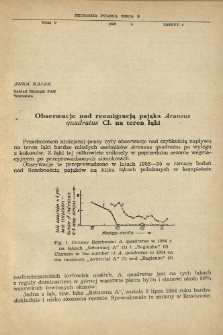
Object
Title: Obserwacje nad reemigracją pająka Araneus quadratus Cl. na teren łąk
Subtitle:
Obserwacje nad reemigracją pająka ; Observations on the migration of Araneus quadratus Cl. To the meadow area
Contributor:
Polska Akademia Nauk. Komitet Ekologiczny
Publisher:
Place of publishing:
Description:
Pages 339-343 ; 24 cm ; Bibliographical references (page 343) ; Abstract in English
Type of object:
Abstract:
The phenomenon of influx of young A. quadratus individuals was noted on the territory of the “Artificial A” meadow; from which following to very scrupulous hay barvest they vanished in the precedent vegetative season (fig. 1). During the period from hay making until end of September there were found at application of both methods (scoop and squares method) 2 individuals only on the meadow explored. Rapid disappearance of A. quadratus occurred already before sexual maturity of separate individuals (tab. l) and so no cocoons were laid at all. Approximate number of nests per 8 stripes about 75 m long and 1 m wide had been examined in June 1955. On the meadow in question no nest was found. It is only from 16th of June that young individuals were catched there. The number of same proved to be in June much smaller than on the compared ,,Bagienko” meadow, nevertheless already in the month of July those numbers take similar figures (tab. II, fig. 2). On the “Artificial A” meadow quantity of A. quadratus proves to be in July 8 times higher than in the year 1953. On other meadows likewise there was recorded in 1955 the increase of number (three times bigber on "Bagienko"). Thus there had to be noted the same tendency to the increase of number than on other meadows, in spite of the fact that the whole population which settled on above meadow had to migrate from neighbouring territories. The phenomenon is probably to be explained by dispersal of young forms by air flight. In the literature on the subject of spiders this way of the youngsters’ migration frotn their nests is mentioned also (S a v o r y 1928, G e r t s c h 1949, B r i s t o w e 1929). The ,,Artificial A” meadow was occupied very fast. Young individuals could be found there simultaneously as on other meadows on which there were nests, although their original number was evidently lower (tab. II). Individuals leaving the nests situated close to the “Artificial A” meadow were compelled to pass the distance of about 300 m to reach the opposite edge of the meadow. In spite of the fact that the whole population which settled on the “Artificial A” meadow is of an immigrating character, changes of number run equally as on the compared meadow (fig. 2) in both vegetational seasons 1954 and 1953.
References:
l. Bristowe, W. S. 1939 - The comity of Spiders - London.
2. Gertsch, W. J. 1949 - American spiders - Toronto.
3. Savory, T. H. 1928 - The biology of spiders - London.
Relation:
Volume:
Issue:
Start page:
End page:
Detailed Resource Type:
Resource Identifier:
oai:rcin.org.pl:114805 ; ISSN 0424-7205
Source:
MiIZ PAN, call no. P.3259 ; click here to follow the link
Language:
Language of abstract:
Rights:
Creative Commons Attribution BY 3.0 PL license
Terms of use:
Copyright-protected material. [CC BY 3.0 PL] May be used within the scope specified in Creative Commons Attribution BY 3.0 PL license, full text available at: ; -
Digitizing institution:
Museum and Institute of Zoology of the Polish Academy of Sciences
Original in:
Library of the Museum and Institute of Zoology of the Polish Academy of Sciences
Projects co-financed by:
Access:
Object collections:
- Digital Repository of Scientific Institutes > Partners' collections > Museum and Institute of Zoology PAS > Scientific Journals
- Digital Repository of Scientific Institutes > Literature > Journals/Articles
Last modified:
Feb 4, 2022
In our library since:
Feb 24, 2020
Number of object content downloads / hits:
56
All available object's versions:
https://rcin.org.pl./publication/97646
Show description in RDF format:
Show description in RDFa format:
Show description in OAI-PMH format:
| Edition name | Date |
|---|---|
| Z. 4. Obserwacje nad reemigracją pająka Araneus quadratus Cl. na teren łąk / Kajak A. | Feb 4, 2022 |
Objects Similar
Andrzejewska, Lucyna Kajak, Anna
Zimny, Henryk
Breymeyer, Alicja
Traczyk, Tadeusz
Kajak, Anna
Dajdok, Zygmunt Kącki, Zygmunt

 INSTYTUT ARCHEOLOGII I ETNOLOGII POLSKIEJ AKADEMII NAUK
INSTYTUT ARCHEOLOGII I ETNOLOGII POLSKIEJ AKADEMII NAUK
 INSTYTUT BADAŃ LITERACKICH POLSKIEJ AKADEMII NAUK
INSTYTUT BADAŃ LITERACKICH POLSKIEJ AKADEMII NAUK
 INSTYTUT BADAWCZY LEŚNICTWA
INSTYTUT BADAWCZY LEŚNICTWA
 INSTYTUT BIOLOGII DOŚWIADCZALNEJ IM. MARCELEGO NENCKIEGO POLSKIEJ AKADEMII NAUK
INSTYTUT BIOLOGII DOŚWIADCZALNEJ IM. MARCELEGO NENCKIEGO POLSKIEJ AKADEMII NAUK
 INSTYTUT BIOLOGII SSAKÓW POLSKIEJ AKADEMII NAUK
INSTYTUT BIOLOGII SSAKÓW POLSKIEJ AKADEMII NAUK
 INSTYTUT CHEMII FIZYCZNEJ PAN
INSTYTUT CHEMII FIZYCZNEJ PAN
 INSTYTUT CHEMII ORGANICZNEJ PAN
INSTYTUT CHEMII ORGANICZNEJ PAN
 INSTYTUT FILOZOFII I SOCJOLOGII PAN
INSTYTUT FILOZOFII I SOCJOLOGII PAN
 INSTYTUT GEOGRAFII I PRZESTRZENNEGO ZAGOSPODAROWANIA PAN
INSTYTUT GEOGRAFII I PRZESTRZENNEGO ZAGOSPODAROWANIA PAN
 INSTYTUT HISTORII im. TADEUSZA MANTEUFFLA POLSKIEJ AKADEMII NAUK
INSTYTUT HISTORII im. TADEUSZA MANTEUFFLA POLSKIEJ AKADEMII NAUK
 INSTYTUT JĘZYKA POLSKIEGO POLSKIEJ AKADEMII NAUK
INSTYTUT JĘZYKA POLSKIEGO POLSKIEJ AKADEMII NAUK
 INSTYTUT MATEMATYCZNY PAN
INSTYTUT MATEMATYCZNY PAN
 INSTYTUT MEDYCYNY DOŚWIADCZALNEJ I KLINICZNEJ IM.MIROSŁAWA MOSSAKOWSKIEGO POLSKIEJ AKADEMII NAUK
INSTYTUT MEDYCYNY DOŚWIADCZALNEJ I KLINICZNEJ IM.MIROSŁAWA MOSSAKOWSKIEGO POLSKIEJ AKADEMII NAUK
 INSTYTUT PODSTAWOWYCH PROBLEMÓW TECHNIKI PAN
INSTYTUT PODSTAWOWYCH PROBLEMÓW TECHNIKI PAN
 INSTYTUT SLAWISTYKI PAN
INSTYTUT SLAWISTYKI PAN
 SIEĆ BADAWCZA ŁUKASIEWICZ - INSTYTUT TECHNOLOGII MATERIAŁÓW ELEKTRONICZNYCH
SIEĆ BADAWCZA ŁUKASIEWICZ - INSTYTUT TECHNOLOGII MATERIAŁÓW ELEKTRONICZNYCH
 MUZEUM I INSTYTUT ZOOLOGII POLSKIEJ AKADEMII NAUK
MUZEUM I INSTYTUT ZOOLOGII POLSKIEJ AKADEMII NAUK
 INSTYTUT BADAŃ SYSTEMOWYCH PAN
INSTYTUT BADAŃ SYSTEMOWYCH PAN
 INSTYTUT BOTANIKI IM. WŁADYSŁAWA SZAFERA POLSKIEJ AKADEMII NAUK
INSTYTUT BOTANIKI IM. WŁADYSŁAWA SZAFERA POLSKIEJ AKADEMII NAUK


































